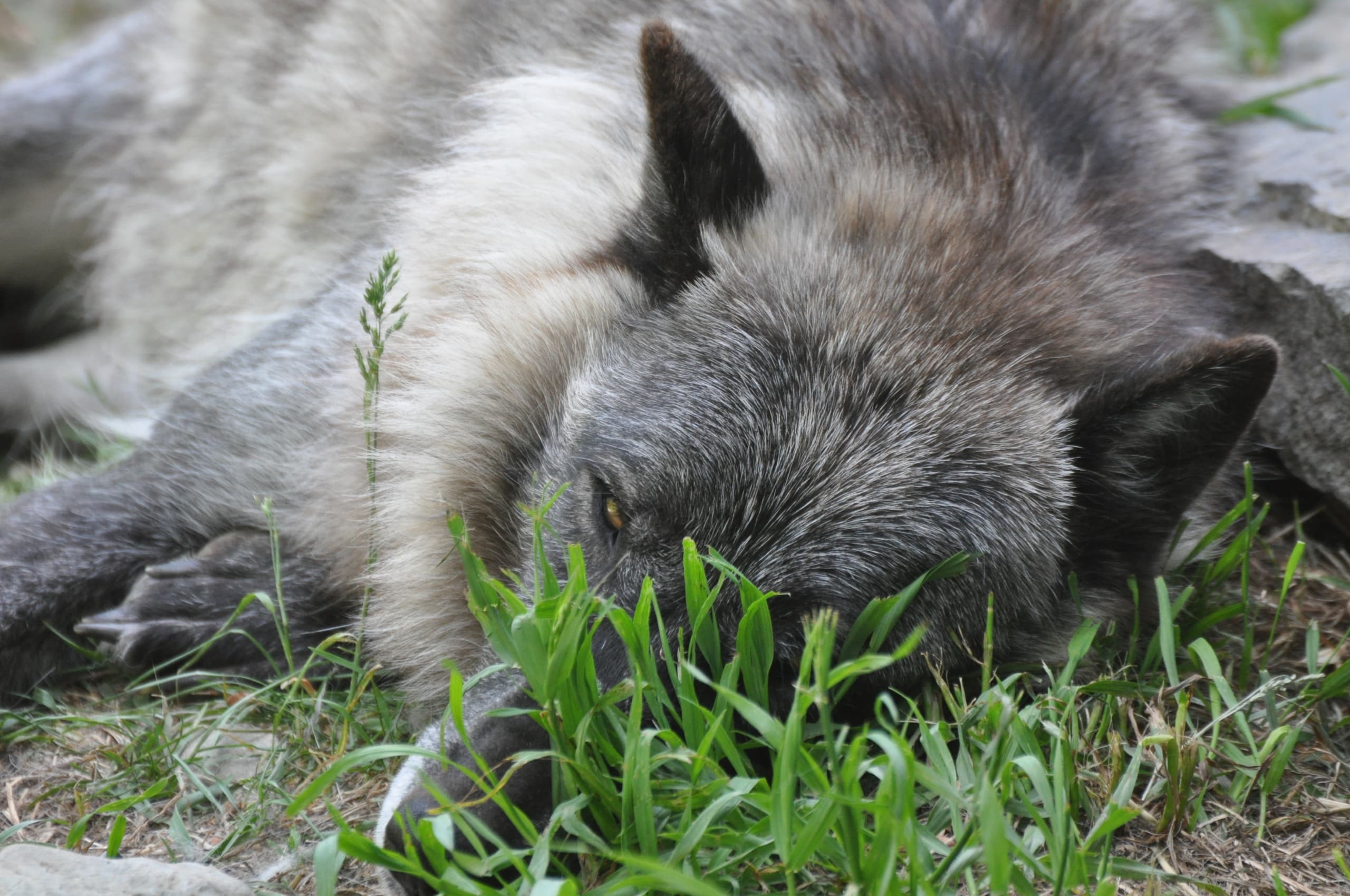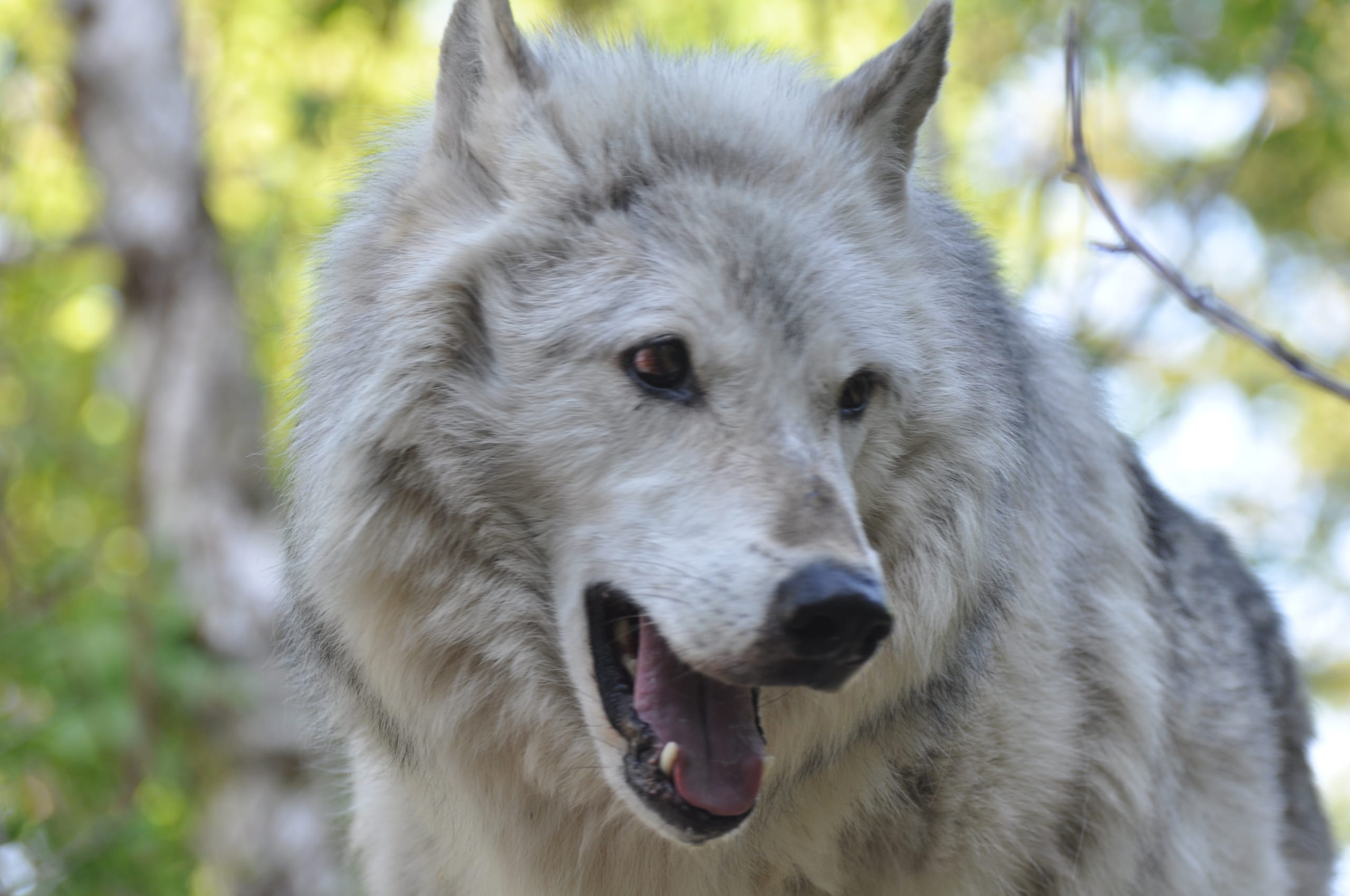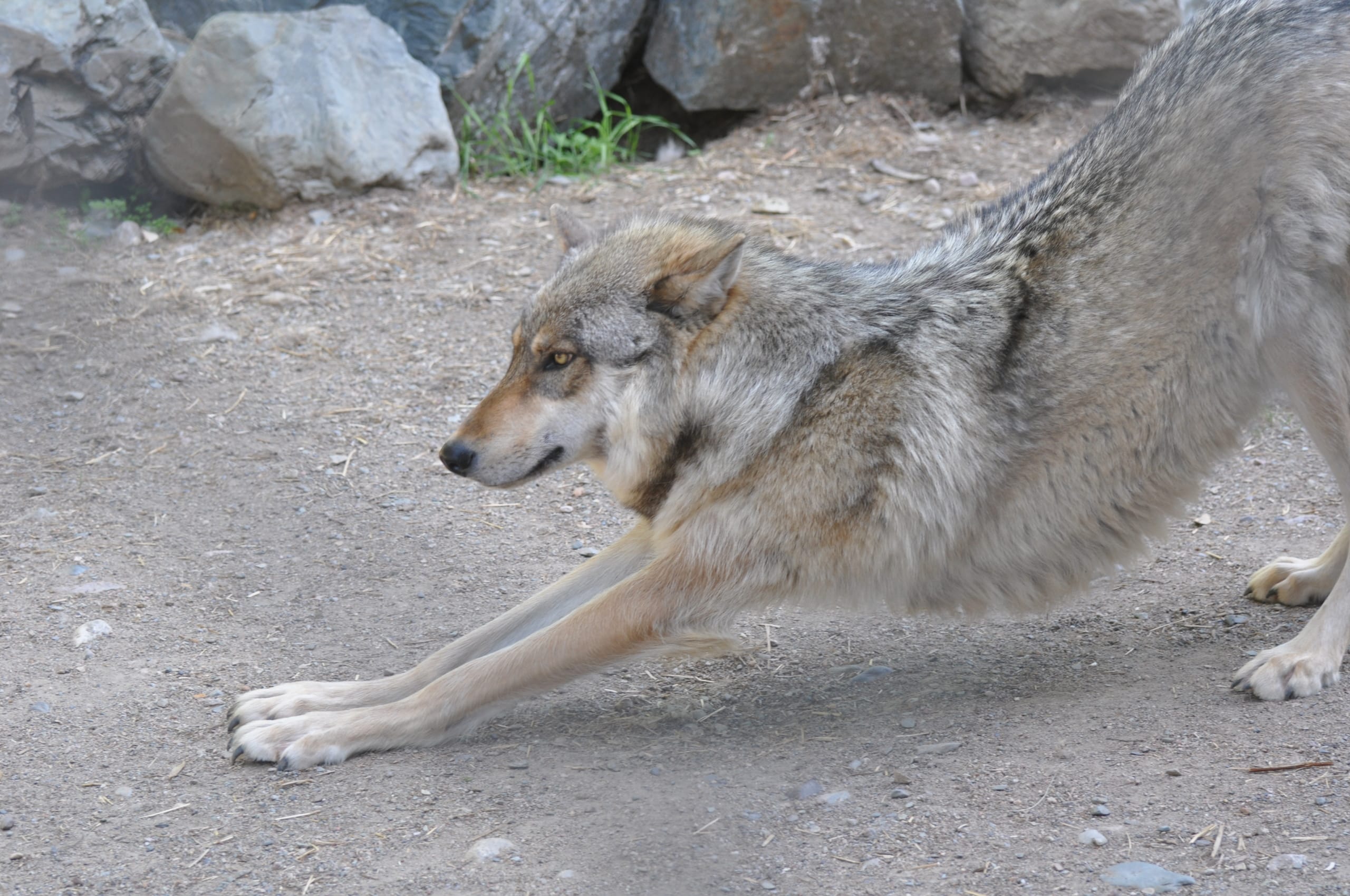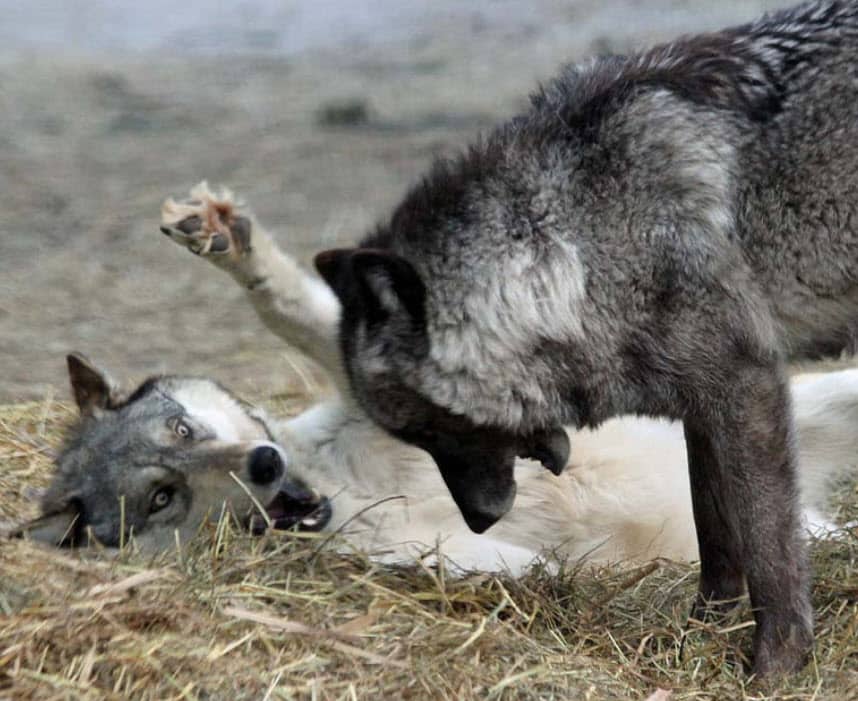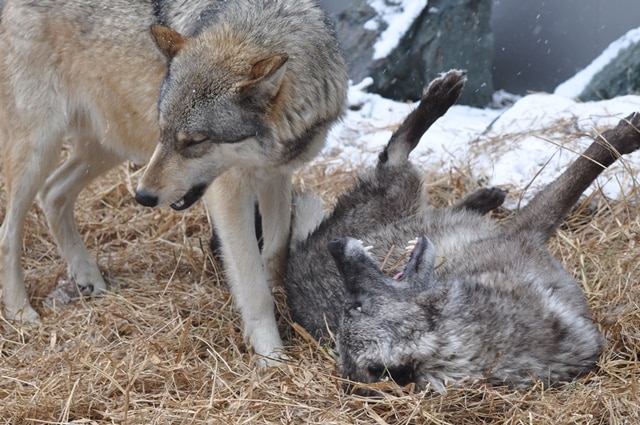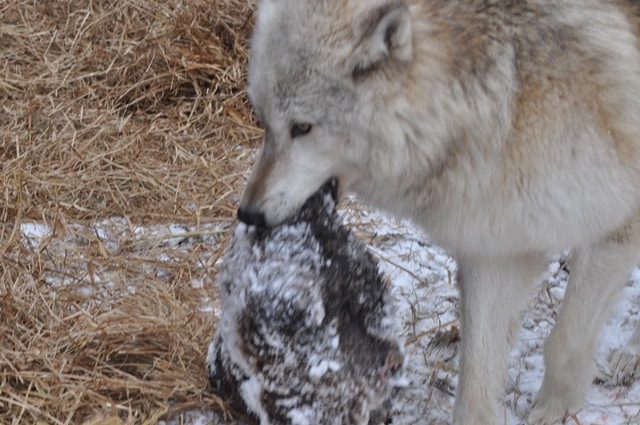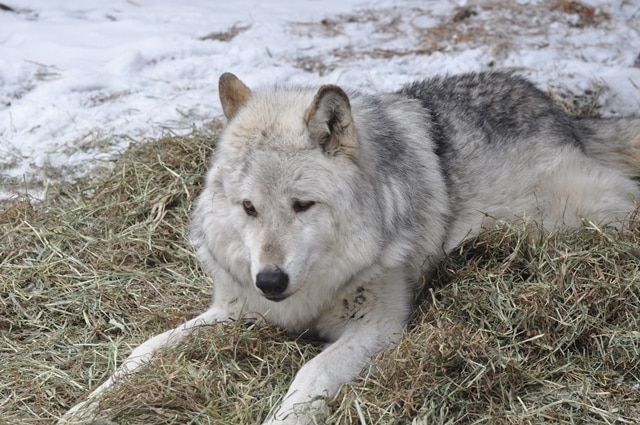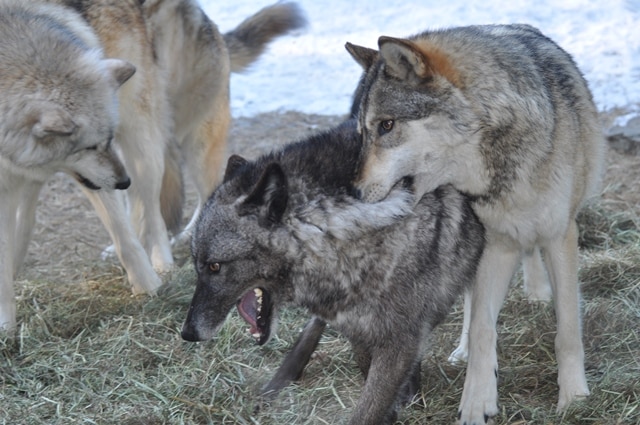When a wolf yawns, it it tired? This question is important as we train the next generation of pup care staff. When we talk about wolf behavior, we try to identify behaviors that indicate a captive wolf might be experiencing stress. We ask people who are participating in pup care or wolf observation programs to be diligent in their observations, not only observing the behavior, but observing the situation and stimuli that motivated the behavior to occur. When a wolf yawns once, it may be tired. When a wolf yawns repetitively, it may be a signal of stress. Other behavioral indicators may be rapid eye movement or blinking, snapping at the air, excessive licking and the obvious, redirected aggression. In this photo, we happened to catch Denali in a yawn as he rested in the sun, but Aidan, that’s a different story.
Archives
Luna is a black color phase of the gray wolf, but her undercoat is nearly pure white. Wolves shed this dense undercoat during the summer season, leaving the sleek permanent guard hairs as their main summer pelage. Luna seeks out sunny places to rest, but the dark coloration of her guard hairs absorbs a lot of heat. To find some relief, Luna will rest in the cool vegetation until the middle of the day, then she tends to find an underground resting spot. Behaviorally, Luna’s been a bit less dominant, lately which could be the cyclical influence of prolactin hormone or the fact that she’s finally maturing. A recent observation on an overnight session captured a display of Luna dominance over Aidan. Initially, it appeared that Aidan and Luna were pairbonding, walking side by side. But, a closer observation noted that Luna was doing a chin rest over Aidan while she was walking. Chin rests are definitely a sign of dominance. Let’s just say that Aidan didn’t appear too impressed with the behavior and the “pairbonding stroll” only lasted about 20 feet.
Grizzer was nicknamed “Grizz” when we picked him up at his USDA facility because we thought he looked like a grizzly cub. When looking at this photo, we definitely still see the big blocky nose that was evident as a pup. As summer approaches, we see less activity from the wolves. But this summer, Grizzer seems to be going into an even more lethargic routine than usual. Because of his age, our concerns are magnified. We were able to take some blood samples without immobilizing (usually an indication that a wolf is not feeling well, they tend to resist the blood draw) and while his CBC’s seemed to be in normal range, there was some indication that his liver functions are on the low end of the range. We started him on some nutritional supplements today and will be watching closely for improvements. Now more than ever, we are committed to the fundraising effort to get the lab extension completed. With this new lab addition, Grizzer could access an indoor kennel via the pack holding area vestibule. Check out our website for the Crowd Rise campaign that combines some current facility needs with efforts to complete this building addition or the Wolf Care Canoe Raffle with all proceeds going directly towards the building. Contact Lori Schmidt at curator@wolf.org for details.
The summer season is the time for wolves to transition into a more nocturnal existence. Boltz was awaken during the middle of the day to have a photo taken. After displaying a fore-stretch and extending his front legs as far as he could reach, he trotted back up the hill to retreat in the cooler forested environment. Such is the life of a summer exhibit. We started the noon enclosure enrichment programs, which we conduct in the summer to help cool the wolves, and give them some stimuli that motivates them to come into view. Today’s enrichment was beaver tails, and Boltz’s wasn’t nearly as adept at locating via scent as the other wolves. He seems to be a bit timid in most interactions, and the search for hidden food tends to create excitement and competition. These are two things that Boltz would rather avoid.
Every wolf has a different personality and Boltz is no exception. He certainly seems to be wary of the unknown and likes to engage in social behavior with those he does know. He continues to be the wolf that works for his meals, but has recently been shown sharing a weekly carcass feeding with both Aidan and Denali. It’s Luna that rarely shares her meal. As part of a spring parasite protocol, we acquired recent weights.
Boltz is believed to be a Great Plains subspecies, and may never reach Aidan and Denali’s weights (both Northwestern subspecies), but his more timid behavior may also be keeping him from maximizing the carcass. We do hand feed Boltz smaller quantities of food whenever we thing he isn’t getting his fair share. His weights as an adult appear to fluctuate between 109 and 112 lbs, which is still a large size for a Great Plains subspecies. It is best to compare him to Grizzer (another Great Plains subspecies) during the same time frame. As a yearling, Grizzer was 93.5, Boltz was 102.5. By the time Grizzer was three, he weighed 110 pounds, similar to Boltz. But, what Boltz might have to look forward to is that when Grizzer met the next generation of Exhibit Pack members in 2009, he must have been taking advantage of extra pup food because his weight between a three year old and a four year old increased from 110 pounds to 121 pounds.
| 6/5/2013 | Boltz | 102.5 lb |
| 8/14/2013 | Boltz | 109.56 lb |
| 6/13/2014 | Boltz | 111.9 lbs |
| 5/1/2015 | Boltz | 109.34 lbs |
Luna rolling on back in the cover hay, but not for long. We will be removing the hay as part of the Working for Wolves program on May 15th. Actually, we may need to do a pre-Working for Wolves hay removal. In the East side enclosure, we removed straw yesterday and discovered a 6 inch layer of ice. So, if we want to truly clean up the enclosure on the Working for Wolves weekend, we need to remove the 18 bales of cover hay that keep the ice intact. As we start the summer season, we are starting a new dose of Ivermectin which treats a broad spectrum of parasites as well as prevents heartworm. In order to ensure we have the proper dose, the wolves were weighed today. Luna weighed in at 97 pounds. This is an increase in weight from her two=year old weight last year of 91.7 lbs and her yearling weight of 82 lbs. A person would only need to watch a “What’s for Dinner” program to appreciate this data.
Denali carries a beaver away from the other wolves and has no problem lifting the 30 lb frozen carcass with the grip of his 4 canine teeth and strong neck muscles. These adaptions make it possible for wolves to hunt prey much larger than themselves. Even though I have worked with captive wolves for nearly 30 years, their physical adaptations are still impressive to watch. Wolf care staff weighed all the wolves this morning before starting a new dose of Ivermectin. Denali’s weight remains steady between 134 and 138 lbs.
| 8/14/2013 | Denali | 138.6 |
| 6/13/2014 | Denali | 134.5 lb |
| 5/1/2015 | Denali | 136.69 |
Even though this image was only taken 7 days ago, a lot has changed. We have finally lost our snowfall, but ice remains under the cover hay and the pond water line is still frozen underground. The incidents of jaw sparring have decreased as the temperatures have warmed up. We had a great webinar for Aidan and Denali’s birthday on April 27th. Denali and Boltz feasted on a large chunk of meat first while Aidan relaxed, then in true wolf form, as soon as the webinar ended, Aidan got his fill. Afterward, he proceeded to display some social interaction with Boltz, before displaying an invite chase to Luna. Before starting Ivermectin treatments in May, we weighed all the wolves. Aidan continues to gain from 129 lbs in 2013 to 137 lbs today. We prefer to have him lose these 10 lbs that have been added in the last two years, but managing one wolf’s diet when a deer is fed can be challenging.
| 6/4/2013 | Aidan | 129 lbs |
| 8/14/2013 | Aidan | 133.32 |
| 6/13/2014 | Aidan | 136.25 |
| 5/1/2014 | Aidan | 137.79 lbs |
We are also concerned that his excess belly fat may be related to higher levels of cortisol due to increased conflict as the dominant male of the Exhibit Pack. In the past, I have written grants for lab equipment to measure fecal cortisol, but unfortunately, I have been unsuccessful. I will continue to seek funding to be able to monitor stress condition for our ambassador wolves, but until then, I will be monitoring other facts that might indicate stress.
Grizzer has had issues with his right eye for several years. He received some tissue damage at the top of his head from altercations with Denali that resulted in some nerve and muscle damage. This resulted in his inability to blink his upper eyelid. His 3rd eyelid or nictitating membrane does close offering some relief from irritation. When we watch nightime surveillance video, we are able to document the movement of this membrane as it obscures the “night shine” of the cornea, at a rate of about 1 movement per every 5 blinks of his left eye. The nictating membrane is important to remove debris from the cornea and it’s wolf care staff’s responsibility to clean debris from the corner of his eye (actually, all the ambassador’s) on a daily basis. During last week’s unusually dry and windy weather, his eye was a bit irritated. To provide him some relief, the veterinarians prescribed an eye ointment that was delivered twice a day. Grizzer willingly took his treatment and his eye is better this week, especially with the return of some moisture to the air. We weighed Grizzer on May 1st as part of the spring medical regime. Grizzer’s weights have fluctuated the last few years, but we are certainly at a heightened state of awareness with Grizzer’s loss of 11 pounds since last spring’s physical. Grizzer is scheduled for a full blood panel later this spring and we definitely want to test all systems to make sure he is aging well. The loss of weight might be in response to the fact that he tripled his real estate by having access to the East Side enclosure after the sad loss of Shadow and Malik.
| 6/4/2013 | Grizzer | 118.6 lbs |
| 8/14/2013 | Grizzer | 122.76 lbs |
| 6/13/2014 | Grizzer | 123.0 lbs |
| 5/1/2015 | Grizzer | 111.9 lbs |
Boltz and Luna were both born in 2012, and even though they had an unusual separation because of Luna’s condition, they were pup mates. Pup mates wrestle, scruff bite, growl, bite some more, snap, bite some more and drag each other around as they practice skills to be an opportunistic predator. When one pupmate is the lone female and is expected to fulfill the rank of the dominant female, it’s hard for the other pupmate to transition to this change in relationship. Will Luna every be anything more than a pup mate to wrestle with? As they both mature, they both may grow out of the need for the pup to pup rough housing. Although, there are times that Aidan and Denali still act like pup mates, so it could just be in their nature. At this point, we just need to calm the rough housing a bit so it doesn’t create a stimuli for Boltz to test Aidan. We’ve been seeing a little testing as he matured, but nothing that Aidan can’t handle. One more winter and then the pups come. Pups will be the change in focus that Aidan needs to give him some relief. If Boltz wants to wrestle, the addition of two male pups in the fall of 2016 will give him the chance.

The International Wolf Center uses science-based education to teach and inspire the world about wolves, their ecology, and the wolf-human relationship.


